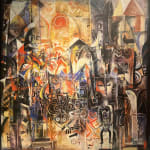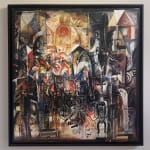

Wosene Worke Kosrof Ethiopian , b. 1955
Wosene Worke Kosrof, was born in 1950 in the Arat Kilo district of Addis Ababa. Formally trained at the Addis Ababa School of Fine Arts where he completed a BFA with distinction in 1972. Together with Tadesse Mesfin and Zerihun Yetmgeta, Wosene studied under the masters of Ethiopian Modernism; Skunder Boghossian and Gebre Kristos Desta. Especially Skunder was a big influence on his earlier work. In 1977 he left Ethiopia to travel and settled in the USA. As a Ford Foundation Talent Scholar, he was awarded an MFA in 1980 from Howard University in Washington, DC.
Over the past four decades, Wosene has created an internationally recognized artistic signature by being the first Ethiopian-born artist to use the script forms – fiedel – of his native Amharic as a core element in his paintings and sculptures. Wosene has described his use of the script form as a way in which to “show the power of language, how words matter,”. Creating a new alphabet grown out of traditional African calligraphy graffiti, colours, textile patterns, woodcarvings, and rituals. Although not to be read literally, there is a story to be told within the abstracted letters and symbols scattered across his canvasses. Within the myriad of brush strokes, Amharic speakers will decipher words, phrases, and terms. In our painting we recognize words like witch, wizard, fortune teller all of which are harbingers of a deep cultural meaning to Ethiopians. References to coffee, injera (the Ethiopian bread) and traditional rituals are some of the topics permeating Wosene’s works but he fuses these African influences with echos of the rhythms of jazz a huge influence on his practice, a reflection of his experience of living in the USA and his affinity with the African American culture. In the present work we can see all these different elements of his practice. The canvas is packed with symbols, geometric forms, figures and letters from the Amharic alphabet in his favourite colour palette of that time, whites, browns, charcoal black infused with vibrant orange and yellow. In several places we can see references to African sculpture, a fertility goddess can be seen in bottom of the canvas, faces in profile or looking back at us. The bright orange sun in the top half of the painting seems to illuminate everything in its surrounding. Just below the center of the painting we see two eyes staring back at us. A recurring motive in his work inspired by the magical eyes used in healing scrolls. In Ethiopian talismanic art eyes are the conduits through which illness-causing demons leave the body. The repeating geometric patterns have a protective function. For Wosene these references are a recognition and celebration of Africa’s intellectual and cultural achievements which have often been overlooked in the West as the result of “The Legacy of colonialist and primitivist thought”.
Join the mailing list
* denotes required fields
We will process the personal data you have supplied in accordance with our privacy policy (available on request). You can unsubscribe or change your preferences at any time by clicking the link in our emails.

